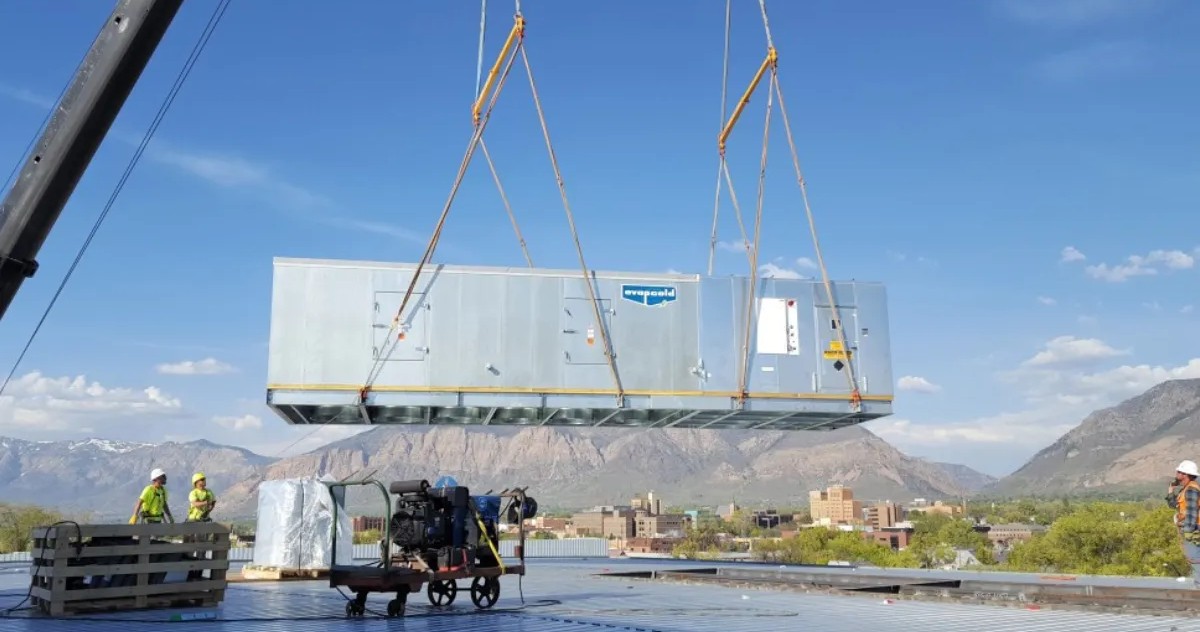Evapco VP details the ESG benefits of packaged low-charge ammonia systems
January 16, 2024

U.S. OEM Evapco has released a video touting the environmental, social and governance (ESG) benefits of packaged low-charge ammonia (R717) units.
Kurt Liebendorfer, Vice President at Evapco, posted the video, which he narrates, to his LinkedIn page. Evapco is a pioneer of low-charge ammonia systems and manufactures them under its Evapcold product line, which includes penthouse refrigeration units, chillers and split refrigeration systems. The company installed its first low-charge ammonia system in 2016 at a cold storage facility in Utah.
In the video, Liebendorfer notes that packaged low-charge ammonia units have low specific energy consumption (SEC) values in cold storage applications. The Evapco VP highlighted the SEC values of his company’s systems, which range from 0.3 to 0.7kWh/ft3/yr (10.8 to 25kWh/m3/yr). During a presentation at the ATMOsphere (ATMO) America Summit 2022, Liebendorfer said centralized ammonia systems have an SEC of between 0.75 and 1kWh/ft3/yr (26.8 and 35.7kWh/m3/yr).
Another low-charge pioneer, Stefan Jensen, Managing Director of Scantec Refrigeration Technologies in Brisbane, Australia, has reported SEC values of 0.57–0.68kWh/ft3/yr (20–24 kWh/m3/yr) in centralized ammonia DX systems.
Along with reducing electricity consumption, Liebendorfer also focused on water savings, which he said can reach up to tens of millions of gallons per year. These savings are realized through the ability to choose from a variety of condenser types that consume less water than the evaporative cooling towers utilized in traditional centralized ammonia systems.
Social and governance benefits
The “social” element of ESG refers to human rights and equity, and in the video Liebendorfer cites an Evapco analysis of leak-exposure radiuses for centralized and packaged ammonia systems. In a 300,000ft2 (27,870.912m2), 1,000TR (3,516kW) cold storage facility, Evapco estimates that a centralized system with a full charge of 20,000lbs (9,071kg) would have a release radius of 5 miles (8km) compared to 800 yards (731m) for a low-charge unit with a full charge of 350lbs (158kg).
Liebendorfer also focused on the safety benefits to workers, specifically those that come from the lack of on-site construction needed to install low-charge systems.
Regarding governance, the video touched on the reduced regulatory burdens that come with low-charge units. Under the International Institute of All-Natural Refrigeration’s Ammonia Refrigeration Management – Low Charge (ARM-LC) guidelines, the burden of ensuring a system is safely operated and maintained falls on the manufacturer for systems that use 500lbs (226kg) of ammonia or less.
In terms of cost savings, Liebendorfer gave the example of rooftop packaged units replacing machinery rooms in centralized systems, enabling warehouses to free up space for additional loading docks and storage. Packaged units can also help a company lower its tax liability, according to Liebendorfer, who said that such systems can be classified as “personal” rather than “real” property. Personal property refers to assets that can be physically moved, with real property referring to land and assets attached to it, such as buildings.
“Packaged and portable refrigeration units can easily qualify for different tax treatment,” said Liebendorfer. “With much shorter capital depreciation as personal property rather than real property, this accelerated depreciation results in significant tax savings.”
In 2022, Evapco entered the transcritical CO2 marketplace in North America with the acquisition of Canadian OEM LMP.


